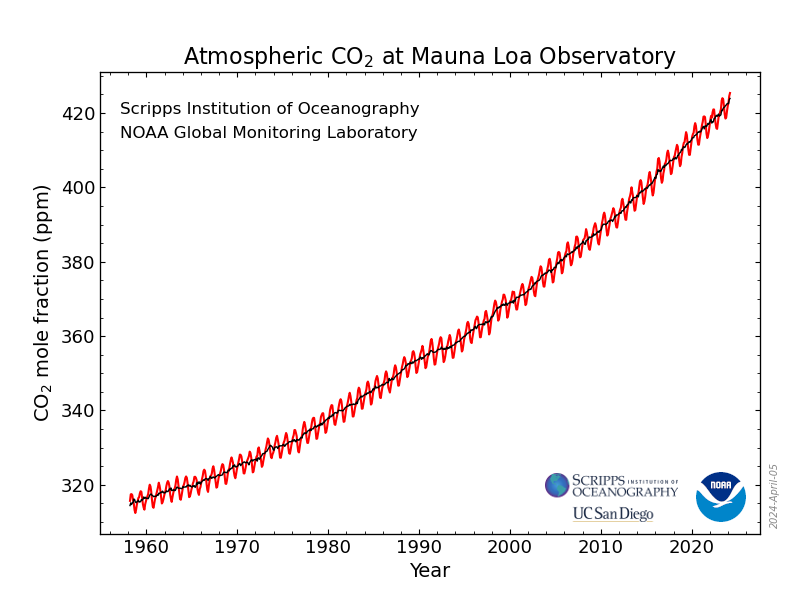 (Illustration found here.)
(Illustration found here.)
Overcast skies cool the air this late-afternoon Monday here in California’s Central Valley as we’re entering a small respite for the next few days from the on-charging heat from the approaching summer days ahead.
Temperatures are in the high 70s right now compared to the high 90s at the same time yesterday — we might even get some rain showers later. Weather is being weathered.
Unless it is being influenced by unnatural, man-made shit.
Beyond the tide of ugly political news today — especially in the T-Rump exploding classified documents case (his layers even tried a visit to DOJ HQ to try and talk prosecutors out of indicting the asshole) — more redlight, blaring warnings at the state of our environment as it’s not looking good at all.
A jump in CO2 — again! From the NOAA this morning:
Carbon dioxide levels measured at NOAA’s Mauna Loa Atmospheric Baseline Observatory peaked at 424 parts per million in May, continuing a steady climb further into territory not seen for millions of years, scientists from NOAA and Scripps Institution of Oceanographyoffsite link at the University of California San Diego announced today.
Measurements of carbon dioxide (CO2) obtained by NOAA’s Global Monitoring Laboratory averaged 424.0 parts per million (ppm) in May, the month when CO2 peaks in the Northern Hemisphere. That is an increase of 3.0 ppm over May 2022, and represents the fourth-largest annual increases in the peak of the Keeling Curve in NOAA’s record. Scientists at Scripps, which maintains an independent record, calculated a May monthly average of 423.78 ppm , also a 3.0 ppm increase over their May 2022 average.
Carbon dioxide levels are now more than 50% higher than they were before the onset of the industrial era.
“Every year we see carbon dioxide levels in our atmosphere increase as a direct result of human activity,” said NOAA Administrator Rick Spinrad, Ph.D. “Every year, we see the impacts of climate change in the heat waves, droughts, flooding, wildfires and storms happening all around us. While we will have to adapt to the climate impacts we cannot avoid, we must expend every effort to slash carbon pollution and safeguard this planet and the life that calls it home.”
Carbon dioxide pollution is generated by burning fossil fuels for transportation and electrical generation, by cement manufacturing, deforestation, agriculture and many other practices. Like other greenhouse gases, CO2 traps heat radiating from the planet’s surface that would otherwise escape into space, amplifying extreme weather events, such as heat waves, drought and wildfires, as well as precipitation and flooding.
Rising CO2 levels also pose a threat to the world’s ocean, which absorbs both CO2 gas and excess heat from the atmosphere. Impacts include increasing surface and subsurface ocean temperatures and the disruption of marine ecosystems, rising sea levels and ocean acidification, which changes the chemistry of seawater, leading to lower dissolved oxygen, and interferes with the growth of some marine organisms.
This year, NOAA’s measurements were obtained from a temporary sampling site atop the nearby Mauna Kea volcano, which was established after lava flows cut off access to the Mauna Loa observatory in November 2022. Scripps’s May measurements were taken at Mauna Loa, after NOAA staff successfully repowered a Scripps instrument with a solar and battery system in March. –
The Mauna Loa data, together with measurements from sampling stations around the world, are incorporated by NOAA’s Global Monitoring Laboratory into the Global Greenhouse Gas Reference Network, a foundational research dataset for international climate scientists and a benchmark for policymakers attempting to address the causes and impacts of climate change.
Add to the CO2 upward crawl, this year’s El Niño cycle, which could increase the rate of CO2 growth in the atmosphere.
Further in context from Ralph Keeling, a geochemist at Scripps (via The Washington Post): ‘“[The findings are] disappointing, but not surprising. We’re still seeing CO2 rise at the same pace as it has for the last few decades … Whatever we’re seeing weather-wise now is just the beginnings of much bigger changes … I expect the news next year to look even worse,”‘
Meanwhile, back to your standard, normal political news cycle with a future bleak as shit.
Warning! Warning! WTF:
CO2 choke, or not, yet here we are once again…
 (Illustration out front: Pablo Picasso’s ‘Les Deux Saltimbanques: l’Arlequin et Sa Compagne,’ found here.)
(Illustration out front: Pablo Picasso’s ‘Les Deux Saltimbanques: l’Arlequin et Sa Compagne,’ found here.)